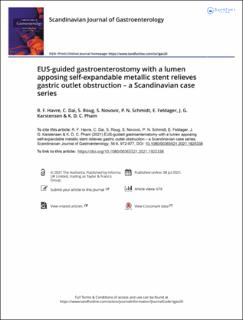| dc.contributor.author | Havre, Roald Flesland | |
| dc.contributor.author | Dai, C. | |
| dc.contributor.author | Roug, Stine | |
| dc.contributor.author | Novovic, Srdan | |
| dc.contributor.author | Schmidt, P.N. | |
| dc.contributor.author | Feldager, E. | |
| dc.contributor.author | Karstensen, J.G. | |
| dc.contributor.author | Pham, Khanh Do-Cong | |
| dc.date.accessioned | 2021-11-29T10:04:17Z | |
| dc.date.available | 2021-11-29T10:04:17Z | |
| dc.date.created | 2021-10-19T20:05:00Z | |
| dc.date.issued | 2021 | |
| dc.identifier.issn | 0036-5521 | |
| dc.identifier.uri | https://hdl.handle.net/11250/2831844 | |
| dc.description.abstract | Background: EUS-guided gastroenterostomy (EUS-GE) with lumen-apposing metallic stents (LAMS) in patients with gastric outlet obstruction (GOO) has proven to be an alternative to luminal stenting in the duodenum and surgical gastroenterostomy. In severely ill patients, the method can provide improved quality of life (QoL) and symptom relief by restoration of the luminal passage of fluid and nutrients to the small intestine.
Aim: To assess the technical and clinical success and safety of EUS-GE.
Material and methods: A dual center retrospective case series of 33 consecutive patients with GOO due to malignant (n = 28) or non-malignant conditions (n = 5). The patients were treated with EUS-GE using cautery enhanced LAMS. Procedures were performed guided by EUS and fluoroscopy in general anesthesia or conscious sedation.
Results: Technical success was achieved in all patients. The median procedure time was 71 min and the median hospital stay was three days. Thirty (91%) patients were able to resume oral nutrition after the procedure. Ten patients (30%) experienced adverse events (AEs), including migration of the stent, bleeding, and infection. Four patients had fatal AEs (12%). All stent-related AEs were handled endoscopically. Five patients (15%) needed re-intervention. The median survival time for patients with malignant obstruction was 8.5 weeks (0.5–76), and 13 patients with obstructing malignancies lived 12 weeks or longer.
Conclusion: EUS-GE is a minimally invasive and efficient method for restoration of the gastrointestinal passage and may improve palliative care for patients with GOO. The method has potential hazards and should only be offered in expert centers that regularly perform the procedure. | en_US |
| dc.language.iso | eng | en_US |
| dc.publisher | Taylor & Francis | en_US |
| dc.rights | Attribution-NonCommercial-NoDerivatives 4.0 Internasjonal | * |
| dc.rights.uri | http://creativecommons.org/licenses/by-nc-nd/4.0/deed.no | * |
| dc.title | EUS-guided gastroenterostomy with a lumen apposing self-expandable metallic stent relieves gastric outlet obstruction–a Scandinavian case series | en_US |
| dc.type | Journal article | en_US |
| dc.type | Peer reviewed | en_US |
| dc.description.version | publishedVersion | en_US |
| dc.rights.holder | Copyright 2021 the authors | en_US |
| cristin.ispublished | true | |
| cristin.fulltext | original | |
| cristin.qualitycode | 1 | |
| dc.identifier.doi | 10.1080/00365521.2021.1925338 | |
| dc.identifier.cristin | 1947140 | |
| dc.source.journal | Scandinavian Journal of Gastroenterology | en_US |
| dc.source.pagenumber | 972-977 | en_US |
| dc.identifier.citation | Scandinavian Journal of Gastroenterology. 2021, 56 (8), 972-977. | en_US |
| dc.source.volume | 56 | en_US |
| dc.source.issue | 8 | en_US |

